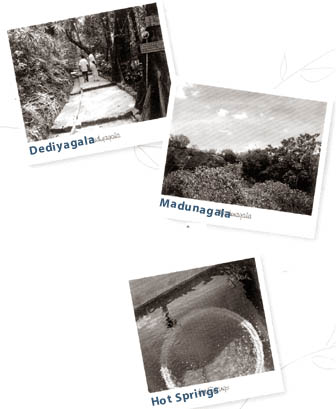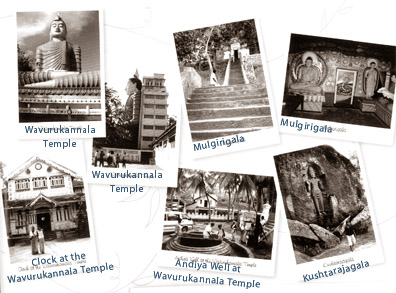|
observer |
|
|
|
|
|
OTHER LINKS |

|

|

|
Jungle Shrines and SaltpansTouring the deep South of Sri Lanka for a day, Ravi Bamunusinghe explores some little known places off the beaten track.
Our first stop was at Kushtarajagala, located on the old road, close to the Weligama Rest House. The name Kushtarajagala is curious as it was named after a king who had sores on his body, thus called Kushtaraja. Kushtarajagala is an 8th century AD rock monument believed to be an image of Bodhisattva. At the time the images of Bodhisattva were worshipped as a tradition of the Mahayana Buddhism. It is believed it was sculptured by King Kushtaraja himself, as penitence for the leprosy from which he suffered . This well-maintained place, with the undupiyaliya beneath the Bo tree offering an atmosphere of tranquillity and peace, is a credit to those people who so meticulously maintain it. Turning off at the Bangama Road situated just after Akuressa, before the Dediyagala town, we came to Dediyagala Monastery. The 4 km long road leading to the monastery, with jungle on both sides, started off as a gravel road before turning into muddy puddles that resembled paddyfields prepared for harvesting. The monastery is bound by no barriers of gates and walls, only the river which silently flows beneath the bridge down to the "Dediyagala" - meaning where two rivers meet. It was noon when we arrived at the monastery and the priests were preparing to partake their midday meal (the only one for the day). As we waited, we observed the inhabitants quietly walking with total self-restraint in their every action. The silence within the monastery harmonised beautifully with the music of birds, the trees and the water flowing nearby. The setting was out of this world and I wished we could have stayed longer. Oliyagan Forest Reserve via Akuressa on the Kamburupitiya road, was next. We found this to be a spectacular wet zone rainforest covering 482.9 hectares of rich fertile land. The Hali-Ela Lake with its serene waters, borders the east end of the forest and is one of the most impressive sights in the reserve.
Travelling via Kirinda, Hakmana and Beliatta our next stop was at the Mulkirigala Rock Temple. The entrance is by a flight of steps paved in stone. We started the steep climb up, which is up three levels, amounting to 350 steps in total. Coming closer to the top, we observed that the steps were cut out of the rock itself, an admirable feat considering its ancient beginnings. After an exhausting climb we were rewarded with a splendid bird's-eye view of the surrounding area and the magnificent dagoba (stupa, domed building) erected at the top. There were seven viharas, (shrines) each with a statue of the Buddha. In one vihara is an abandoned underground tunnel supposedly used by King Saddhatissa, the architect of the vihara. The paintings at Mulkirigala were noticeably rich in colour, when compared to paintings found at similar historic sites. One painting depicts a woman in a procession, playing a musical instrument, which was very unusual for females of that period. Wavurukannala temple is not very far on the Beliatta Road at Dikwella. We were amazed at the massive Buddha statue, there and it has a structure erected beside it to enable people to climb to the top of the statue. At the top, one can look at the enshrined relics of the Lord Buddha in little caskets placed inside the head; a unique way to symbolise the sanctity of the relics. Sri Lankans consider this Buddha statue, which is as high as a five-storey building, the tallest in the world. The structure placed at the rear of the statue is not visible from the front, thus making the magnificence of the statue against the blue sky even more remarkable. There is an interesting museum at the temple, while another fascinating feature is the water supply to the temple. This comes from an 'Andiya well' (a deep hole dug into the ground where the water is levered using a horizontal wooden pole to which is attached a rope carrying a container to draw the water). This was a refreshing change from the common well and more so because this form of well is rarely found, even in areas where it was once commonly used. Having reached Ambalantota via Karambagalmulla our next destination was the ancient Madunagala Monastery. As we drove in a south-easterly direction we noticed the lush green landscape of the south-west gradually turning into more open spaces, the typical landscape of the dry zone. When we reached the monastery, which is situated amidst a thick jungle of thorny bushes, cacti and shrub, the weather was rather hot and the cool breeze blowing from time to time was very welcome. This monastery dates back to the Aunuradhapura period and was founded by Sri Gnananandabhimana Mahanayake Thera, who had retreated to the jungle in order to meditate and reflect upon the worldly life. The monastery itself is made up of many natural caves, which the present day priests use as a place of meditation and living quarters. The stupa situated at the summit of the monastery is visible at the entrance through the thick jungle, and there is a flight of steps for a closer glimpse of it. In the vicinity of Madunagala Monastery is the Mahapelessa Hot Springs. Legend says the first well, which contains very hot water, is believed to be from the original hot springs, the bubbles foaming on the surface is a good indication of the high temperature. The water from the second well is fed through a conduit and thus it was lukewarm. These waters are believed to be effective in treating rheumatic pain and other skin eruptions and of course tired feet, like it did for us. We did not forget to visit the saltpans, east of Hambantota. It provides a rare experience to witness how salt is produced. A large numbers of birds - such as gulls, ducks, flamingo, spot billed pelican, sandpipers - are common to this locality. With plenty of fish around, it was easy to understand why the birds stood so patiently in rows waiting for the valuable catch to come along. Visitors to the saltpans should wear a tie-on hat (the breeze as well as the sun is strong) and some sunscreen lotion to be spared the discomfort of the blazing sun. Courtesy Explore Sri Lanka |
 We left Colombo by road in the wee hours of the morning.
We left Colombo by road in the wee hours of the morning.  The forest is the habitat of many endemic birds and we enjoyed bird
watching from the platform erected for the purpose. On the way to the
forest reserve we passed the Nilwala National Education Faculty for
Sports, a well-maintained and exemplary learning institute.
The forest is the habitat of many endemic birds and we enjoyed bird
watching from the platform erected for the purpose. On the way to the
forest reserve we passed the Nilwala National Education Faculty for
Sports, a well-maintained and exemplary learning institute. 







